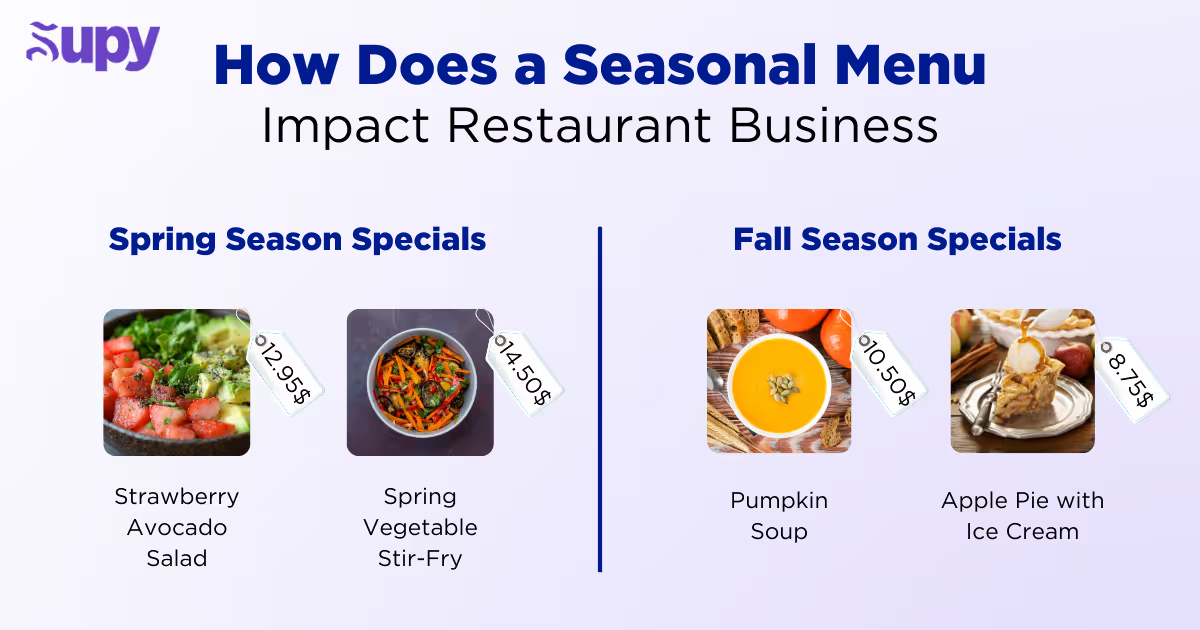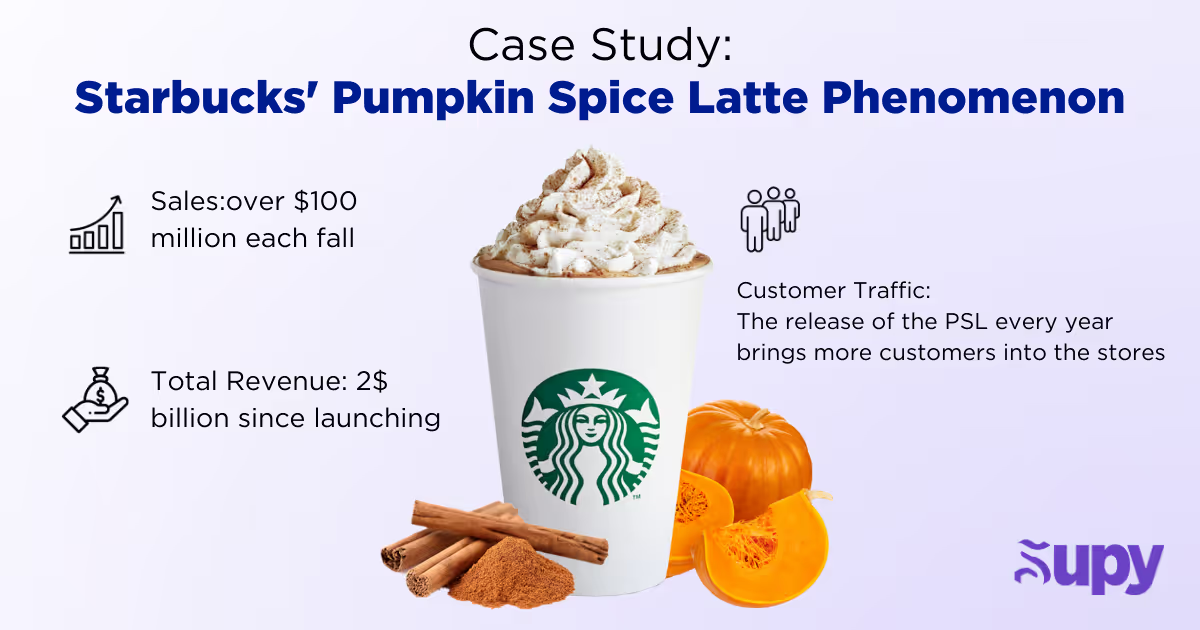The Impact of Seasonal Menu Planning on Restaurant Profitability

With so many restaurants competing for attention, making yours stand out can be challenging. Seasonal menu planning offers a fresh way to get customer interest and set your establishment apart. Research highlights significant consumer preferences for seasonal menu items, showcasing:
- 59% of consumers are more likely to choose a dish labeled as “seasonal.”
- 49% find these items more appetizing.
- 39% consider them healthier.
As a restaurant owner, updating your menu with seasonal items can meet customer expectations and optimize costs using in-season produce. This keeps your offerings fresh and can increase your profitability.
In this blog, we’ll look at:
- What is a Seasonal Menu?
- How Does a Seasonal Menu Impact Restaurant Business?
- Case Study: Starbucks' Pumpkin Spice Latte Phenomenon
- Maximizing Benefits with Seasonal Menu Planning
- Why Inventory Management is Crucial for Seasonal Menus
- Conclusion
- About Supy
Let’s explore how tapping into seasonal trends can help your restaurant thrive in a competitive market.
1. What is a Seasonal Menu?
A seasonal menu changes throughout the year to use ingredients that are fresh and plentiful during certain times of the year. Focusing on what's currently in season allows restaurants to offer dishes that are fresher, more flavorful, and nutritious. With this approach, establishments can ensure every dish served is at its peak for both taste and nutritional value.
For example, a restaurant might serve dishes with strawberries and avocados in the spring when they're in season and switch to pumpkins and apples in the fall. This keeps the menu interesting and supports local farmers by buying what they grow when it’s ready to harvest.
Seasonal menus are particularly beneficial for restaurants aiming to adopt sustainability. This approach is commonly practiced in regions like Australia and the UK, where restaurants focus on using in-season fruits, vegetables, and seafood to lower their environmental impact.
Sourcing ingredients locally reduces the need for long-distance transportation and extensive storage, reducing carbon emissions. In addition to supporting sustainability, this strategy aligns with the growing demand from customers who value eco-friendly and fresh dining options.
2. How Does a Seasonal Menu Impact Restaurant Business?

Seasonal menu planning can benefit your restaurant in several ways:
Sustainability and Quality in Seasonal Dining
A seasonal menu highlights the use of locally sourced ingredients that are at their peak. This ensures that the menu items served are not only bursting with vibrant flavors but are also healthy. Since these vegetables and other ingredients don’t have to travel far, they retain their freshness and nutritional benefits, enhancing the dining experience.
Supporting local farmers is a key advantage. When restaurants procure their ingredients from nearby farms, they help sustain the local economy and ensure that these small-scale producers remain operational. This close relationship with farmers guarantees that the ingredients are harvested at the perfect time, maximizing their taste and quality.
Moreover, using locally sourced ingredients reduces the need for long-distance transportation, significantly cutting down on carbon emissions associated with food transport. This practice supports environmental sustainability by reducing the restaurant's overall carbon footprint.
Interestingly, 80% of diners in the UK are likely to choose dishes that feature local ingredients or seasonal twists. This trend provides restaurants with a powerful marketing tool and can attract customers who value freshness and the ethical sourcing of ingredients.
Reducing Food Costs with Seasonal Ingredients
Implementing a seasonal menu can significantly reduce food costs by utilizing locally sourced, in-season ingredients. Fruits and vegetables are less expensive when they are abundant, and this is often during their natural growing season.
Proper research into ingredient seasonality is key, especially when dealing with items like seafood. For example, mussels, a popular ingredient in many dishes, are more cost-effective when sourced based on their seasonality. In winter, restaurants can import mussels from countries in the northern hemisphere, such as France or the Netherlands, where they are abundant. In summer, sourcing from Australia or New Zealand provides fresher, in-season mussels. Planning and understanding these seasonal shifts helps restaurants maintain quality while lowering costs.
Seasonal ingredients offer fresher options and can lead to fluctuating prices based on availability. When ingredients are in peak season, their cost tends to drop, further minimizing the need for extensive transportation and refrigeration, decreasing overall expenses. Local sourcing also means shorter travel distances for produce, reducing fuel and storage costs while contributing to a lower carbon footprint.
Boosting Profits with Seasonal Menus
Seasonal menus not only enhance the dining experience but also significantly increase restaurant sales. Incorporating seasonal and locally sourced ingredients captures the interest of customers who value freshness and regional flavors, keeping up with changing food trends and market demands.
Incorporating dishes that use locally sourced ingredients can also enhance profitability due to lower food costs. Statistics show that seasonal menus are linked to a 26% jump in orders from diners, which can substantially improve a restaurant's bottom line. Preparing limited-time offerings creates a sense of urgency that motivates customers to dine more frequently, boosting overall profitability as patrons rush to experience new flavors before they're gone.
Enhancing Dining Experiences
Offering a seasonal menu allows restaurants to keep the dining experience fresh and exciting. Regular updates with new foods not only introduce diners to unique flavors but also generate excitement about what’s coming next. This continuous refresh provides great opportunities for upselling and cross-selling.
For example, a seasonal dish can be paired with a specialty drink or a unique dessert, encouraging guests to spend more per visit. These strategic pairings can enhance the overall meal while increasing the average sale per customer.
Feedback from customers on these seasonal offerings is invaluable, enabling restaurants to adjust their menus effectively to meet evolving tastes. Such responsiveness ensures the dining experience remains top-notch, consistently meeting or exceeding customer expectations. Moreover, the novelty of new dishes maintains a vibrant and engaging atmosphere that attracts both new and regular customers.
Variety and Innovation in Menu Offerings
Introducing a variety of seasonal dishes allows restaurants to showcase their culinary creativity and respond to market trends. Each season brings an opportunity to experiment with new ingredients and recipes, keeping the menu dynamic and interesting. This variety caters to the adventurous flavor profiles and attracts diners eager to explore new culinary experiences.
Regular updates to the menu with seasonal items keep the restaurant relevant and engaging, making it a topic of conversation among food enthusiasts. This continual innovation can transform a restaurant into a destination for those keen to discover what new dishes will be featured next. It also reassures regulars that the restaurant is committed to innovation and quality, fostering trust and loyalty.
Actively rotating their menu, restaurants tap into niche markets and attract a diverse clientele looking for authentic, seasonal cuisine. It broadens the customer base and grows the restaurant's reputation as a forward-thinking establishment committed to quality and freshness.
3. Case Study: Starbucks' Pumpkin Spice Latte Phenomenon

Starbucks introduced the Pumpkin Spice Latte (PSL) in 2003, and it quickly became a fall favorite. Every year, customers look forward to its return, showing how a seasonal drink can become a cultural icon and a major sales booster.
The Pumpkin Spice Latte's launch each fall is a big event for Starbucks. It draws in customers who are eager to enjoy the seasonal flavor again. This excitement helps increase the number of people visiting Starbucks, which is great for business.
Key Impacts:
- Sales Contribution: The PSL brings in over $100 million each fall.
- Total Revenue: Since it started, PSL sales have earned Starbucks more than two billion dollars.
- Customer Traffic: The release of the PSL every year brings more customers into the stores.
Starbucks uses the Pumpkin Spice Latte to keep customers coming back and to attract new ones. This drink shows the success of adding seasonal items to the menu and helps Starbucks stand out as a leader in the coffee industry.
4. Maximizing Benefits with Seasonal Menu Planning

Seasonal menu planning can significantly enhance your restaurant's operations and customer appeal. Here are some strategies that can add to your restaurant's success:
- Source Ingredients Based on Global Seasons: One of the key strategies for effective seasonal menu planning is understanding the global availability of ingredients. For Example, from November to February, sourcing ingredients like fruits and seafood from the northern parts of the world, such as Europe or Turkey, ensures freshness and lower costs. Conversely, from May to September, ingredients from the southern hemisphere, like Australia or New Zealand, are in peak season, providing optimal quality. This global approach helps restaurants maintain high-quality dishes year-round while managing costs effectively.
- Implement Dynamic Pricing Strategies: You can use seasonal ingredients to adjust your pricing. For example, when strawberries are in peak season and prices drop, introduce a special strawberry dessert at a reduced price to draw in more customers. Dynamic pricing can also apply to high-demand periods: consider offering a unique, seasonally-inspired dish at a premium price during holidays or local festivals to boost revenue.
- Enhance Marketing Efforts with Seasonal Themes: Leverage seasonal changes in your menu as a focal point for marketing. Create excitement and anticipation by previewing upcoming menu items on social media. Organize events like seasonal menu previews or tasting dinners to engage your community and create buzz around new offerings.
- Strengthen Community Ties Through Local Partnerships: Develop relationships with local producers to source fresh ingredients for your seasonal menu. Promoting these partnerships can boost your restaurant's community image. Consider spotlighting a different local vendor each month in your marketing materials to share the story of where your ingredients come from, adding authenticity and interest to your dishes.
- Boost Staff Engagement and Development: Keep your kitchen staff motivated and growing professionally by rotating the menu regularly. This encourages them to experiment with new ingredients and techniques, which can lead to higher job satisfaction and better culinary results.
5. Why Inventory Management is Crucial for Seasonal Menus

Effective inventory management is essential for restaurants that specialize in seasonal menus. It ensures the availability of fresh, seasonal ingredients that are crucial for maintaining the quality and appeal of the menu. Precise inventory control is key to avoiding shortages and excess, which can impact both customer satisfaction and operational costs.
1. Implement Advanced Inventory Management Software
Given the seasonal variations in your menu, it's crucial to employ an inventory management system that can effectively handle these changes. Opt for software like Supy, which provides features such as real-time tracking and automated reordering capabilities.
Configure the system to send alerts when stock levels of key ingredients are low or when there's a risk of overstocking perishable items. This ensures you maintain optimal inventory levels, preventing both shortages that could affect menu availability and excess that could lead to unnecessary waste.
2. Schedule Regular Inventory Audits
Develop a routine to regularly review your inventory and incorporate unexpected spot checks throughout the year. These audits are crucial for maintaining an accurate record of your stock levels compared to what your books indicate.
Regular checks allow you to identify discrepancies early, such as if certain ingredients are being depleted faster than anticipated or if others are underused. Maintaining strict oversight helps you adjust ordering practices in real time, ensuring optimal inventory levels that reflect your current menu needs and prevent waste.
3. Apply Menu Engineering Techniques
Menu engineering is essential for maximizing the profitability and appeal of your seasonal offerings. It involves analyzing the performance of various dishes on your menu to understand which are favorites and which may not be resonating with your customers. Utilize sales data to evaluate the popularity and profit margins of each item.
Based on this analysis, you can strategically decide which dishes to promote more heavily, which to tweak for better performance, and which to discontinue. Aligning your inventory orders with these insights ensures that you are efficiently managing resources, investing in ingredients that contribute to your most successful dishes, and continuously updating your menu to enhance both cost-effectiveness and customer satisfaction.
4. Strengthen Supplier Communications
Effective communication with your suppliers is crucial when managing a seasonal menu. It ensures you have the necessary ingredients available when needed, especially as your menu changes. Regularly update your suppliers on anticipated changes in your menu and any seasonal shifts that might affect ingredient demand.
This proactive approach allows for quick and efficient adjustments to your orders, ensuring you receive fresh ingredients on time and maintain a consistent quality in your dishes. Keeping your suppliers informed and engaged can help you better manage the flow of ingredients and minimize disruptions in your supply chain.
5. Utilize Predictive Analytics for Demand Forecasting
Understanding future demand for your menu items is key to efficient inventory management, especially with seasonal fluctuations. Predictive analytics helps you anticipate these changes more accurately. Start by integrating historical sales data, seasonal trends, and local market activities into your analysis.
This way you can adjust your inventory orders with greater precision, minimizing risks associated with overstocking or understocking. By forecasting demand effectively, you can ensure that your restaurant is always prepared to meet customer needs without excess expenditure on unused stock.
6. Conclusion
Seasonal menu planning significantly enhances restaurant operations by offering fresh flavors and improving profitability. Effective strategies like dynamic pricing and robust marketing campaigns increase customer interest and spending. Building strong ties with the community through local sourcing also bolsters a restaurant's reputation for quality and sustainability.
Additionally, maintaining precise inventory management is critical in adapting to seasonal menu changes, ensuring smooth operations and meeting customer expectations. Integrating these practices within restaurants will keep your offerings interesting and position yourself as innovative leaders in the industry.
7. About Supy
Navigating the complexities of seasonal menu planning requires precise inventory management, and that's where Supy excels. This advanced system offers real-time tracking, automated reordering, and analytics to keep your inventory perfectly aligned with seasonal shifts. Supy empowers restaurants to optimize their operations, minimizing waste and maximizing profitability as they adapt their menus to get the freshest ingredients each season.
Book a demo today with Supy and enhance your restaurant's inventory management to match your culinary creativity.
Related Resources







